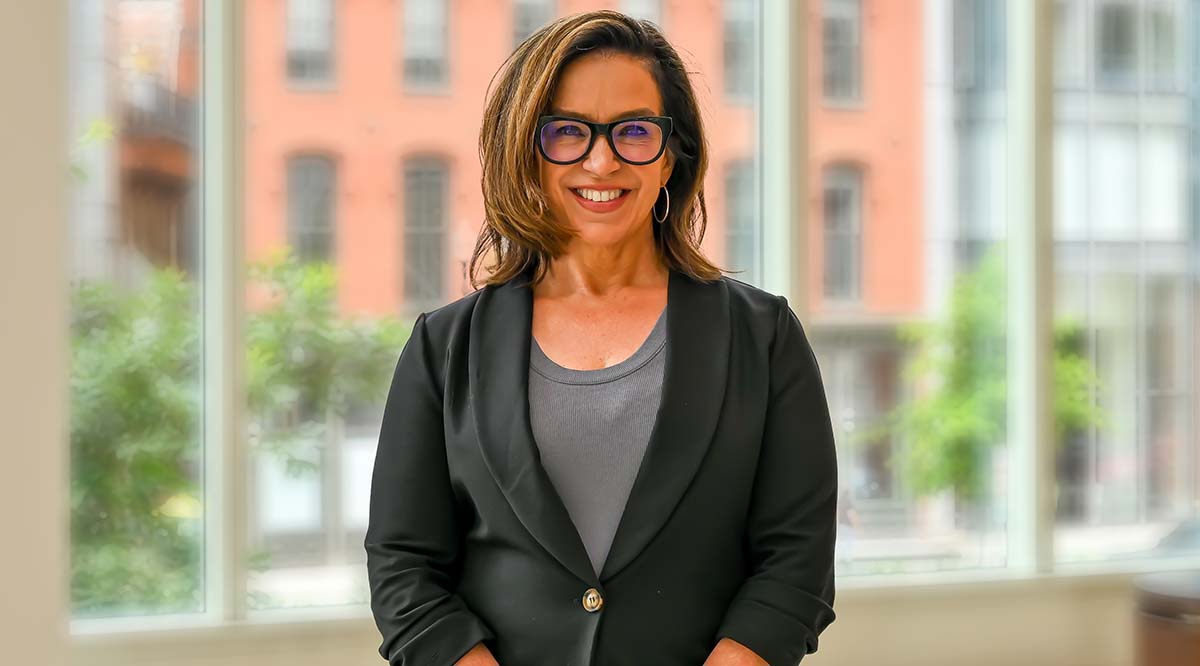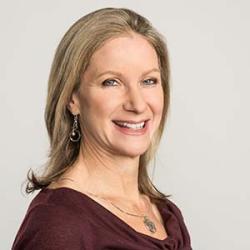
When Susan Cato joined the AAMC as senior director of digital communications in January 2020, she had no idea that her 30 years of leading digital strategy and engagement efforts for various nonprofit associations would become so critical. Just a few short weeks later, the entire world was communicating virtually, learning to leverage technology to accomplish what previously had been done in-person.
Cato’s vast experience with implementing digital strategies to transform the way associations communicate with their members enabled the AAMC to host a clinical guidance repository for clinicians to learn about the novel coronavirus, set up a virtual community for members to communicate directly with each other, and host a variety of online events, including the popular Mask Me Anything event that attracted media and members.
On January 19, Cato was named the chief communications and marketing officer for the AAMC, where she will lead the development, oversight, and implementation of a comprehensive communications and marketing program to support the AAMC’s strategic priorities, brand recognition, policy priorities, reputation, crisis communications, digital experience, and marketing campaigns.
AAMCNews recently sat down with Cato to discuss the challenges and opportunities she sees in her new role, as well as her priorities for the next year.
You worked for a number of associations leading digital strategy and stakeholder engagement. Can you talk about this work and how you envision using these skills in your new role as AAMC Chief Communications and Marketing Officer?
I’ve worked for nonprofit associations for 30 years, including professional societies, industry associations, and membership organizations. There are two themes that have emerged from my journey, although my entire career pretty much has been in digital. My focus has been centered around how we leverage digital to make what we’re doing come alive. How do we improve engagement? How do we increase understanding? How do we create mechanisms that enable us not just to do what we’ve always done, but perhaps do things differently? It’s the digital transformation mindset. Many people think digital transformation is taking what you’ve always done and just putting it online. That is not it. Digital transformation really is identifying opportunities to use technology to do something perhaps completely different, something very innovative, something even more impactful ... asking ourselves what the opportunity for us is to engage more, to partner, to leverage technology in ways that solve problems, give people ideas, [and] inspire them. The other thing is really all about what I call being community centric. The beautiful thing about digital technology is it gives us the opportunity to co-create experiences, content, and solutions with our members, our constituents, our communities in ways that would not have been possible if we did not have these technologies.
You came to the AAMC right before the pandemic as senior director, digital communications. This was an incredibly difficult period for academic medicine, as hospitals were overwhelmed with patients, medical research was suspended and then refocused primarily on COVID-19 treatments and vaccines, and medical education was upended. What were your priorities as the leader of digital comms to support our members during this very difficult time?
Well, first and foremost, I had to make sure the team was OK, because if not, we wouldn’t be able to help and support our members in the ways that they really, desperately needed at the time. We quickly launched some approaches to engage the digital team to make sure we remained connected, and to make sure we were continuing to develop relationships even though we were all remote. Second, communications is more than messaging. Of course, the messaging piece, the public relations piece, the crisis communications piece is really important to stay on top of what was going on and to communicate about those things. There are other approaches that are incredibly important, especially coming from a digital perspective. We asked ourselves what role could we play as a communications team to help support our constituents, help support the people on the front lines, whether it be creating mechanisms for people to share best practices or protocols or guidelines, creating mechanisms for our constituents to actually talk to each other and have conversation back and forth in real time through either virtual community, or other mechanisms so that they were able to learn and go to each other for problem solving. Again, this is really all about the collective working together to solve big problems.
When we were talking about masking, we leveraged platforms like YouTube and other social channels to host live events like Mask Me Anything to address a lack of understanding, and some of the misinformation. We partnered with our Health Care Affairs cluster [to create a clinical guidance repository], and we made it nimble so that we could continuously upload new content, documents, [and other] information very, very quickly. In order to rise to the challenge, we needed it to be agile and nimble using the tools and mechanisms at our disposal. And that was a key, critical resource.
COVID-19 was new territory for all of us. We were in a situation that we had never been in and it was really important to learn from the journey. We felt it was important to document this journey both to honor those on the front lines and to remind us of how we handled the experience, so the team produced a short form documentary called This Is What We Do: Academic Medicine’s Rising to the Challenge of COVID-19, telling the story of our journey as a community through COVID-19. We’re not done [with COVID], of course, but I’m really proud of that piece because it tells the story from the perspective of the medical centers and the people who really made a difference during the pandemic.
The AAMC is known for the MCAT® exam and for the AMCAS® and ERAS® programs, but in fact, the association does a lot of other work with the community. How do you plan to communicate that value to the members?
One of our responsibilities is to make sure that our audiences understand the depth and breadth of what we do. We have been very good about rising to the challenges in the moment and responding to things that may impact our medical centers and our constituents from a societal and political perspective. There are a whole host of other things that we do that I think we need to do a better job of communicating … [including] raising the visibility and awareness of the important work that this organization is doing on the ground, everything from The Principles of Trustworthiness, to partnerships to address vaccine hesitancy and access to care, to elevating the importance and need for funding for medical research. A lot of people in our community do not know this. Certain audience groups, including policymakers and students, don’t really understand the depth and breadth of what we do and the impact that we have on the health and well-being of patients, families, and the community. We are known for the MCAT exam and ERAS, and that is only a small piece.
The AAMC has for many years been working to become an antiracist, inclusive, more diverse organization. More recently, the AAMC has written DEI [diversity, equity, and inclusion] competencies, launched the Center for Health Justice, and released statements in support of DEI issues. As the association has become more vocal, it has gotten some criticism for being “too woke.” What role does the communications division at the AAMC play in responding to this criticism — and is there more it should or could do?
I think we have been doing a great job of responding to each issue that comes up as it happens. I am of the opinion that [we have] to do a better job, number one, of telling the stories of impact when we implement these initiatives. We communicate facts, we show figures, we share information and resources all the time. If we want to increase understanding about these issues, we have to do a better job at the storytelling piece. AAMCNews does a great job of storytelling in the written format. I do believe we have to do more with different mediums, whether it be video, case studies, on-the-ground perspectives of the individuals who are involved or impacted. Secondly, I do think we need to start rounding out how we are talking about these topics and issues. If our North Star is “better health for all” and we have data that demonstrate the positive impact of implementing things like the DEI competencies, how race-conscious admissions is critical, or the importance of access to reproductive care, we need to be telling that story in a way that helps connect our audiences to that message. Is this going to change everybody’s mind? No, but it’s important to focus on increasing understanding. We are here to demonstrate from a data-driven perspective why these things are important to achieving better health for all.
What are your top three or four priorities for the coming year from a communications perspective?
The breadth and depth of what we do as a communications team is broad. Not only do we [the AAMC] have Strategic Communications, which includes media relations, public relations, AAMCNews, crisis communications, [and] advocacy communications. … We also have marketing projects, programs, and services along with creative design teams, user experience, the multimedia team, social media, and virtual communities. My first priority is back to the team, because if the team isn’t set up in a way that allows them to be agile, innovative, and productive, we would not be able to rise to these challenges in meaningful and creative ways, and we won’t be as effective. So my number one priority is getting our team to a place where we can do those things effectively and that’s an ongoing journey.
Another priority would be … increasing the visibility of the breadth and depth of what the organization does and particularly with certain audiences. I do think [we need to] become a little bit more community centric and partner with our members and constituents. For us to address and solve big problems, we are going to have to do it together with our community, with our constituents. … Our fourth mission is community collaboration. If we can hold space in a way that allows people of different perspectives to come in and contribute, I think that will be a win for the communications team, for the organization, and for the community at large.
Will our constituents notice anything different in the coming year?
We, as an organization, because of all the things we’ve just talked about, [are] growing and evolving. … We are a very proud organization that has done wonderful things over the years, and we will continue to evolve. From a brand perspective, it’s really important to honor that and to be very transparent and authentic with how we show up and how we talk about who we are. Our brand as an organization is going to be something we’re going to be looking at to make sure it represents who we are today and where we’re going. Secondly, how we engage online, on social channels will be focused on bringing people into conversations that are meaningful and useful for everybody involved. How do we share third-party content and resources from other people who are inspiring or helpful? So we’re going to see a bit of a difference in how we’re interacting on the social channels as well. Finally, we are making sure that our overall digital user experience is the best possible version that it can be at any given time — providing a valuable online home that supports our constituents in impactful and meaningful ways.
